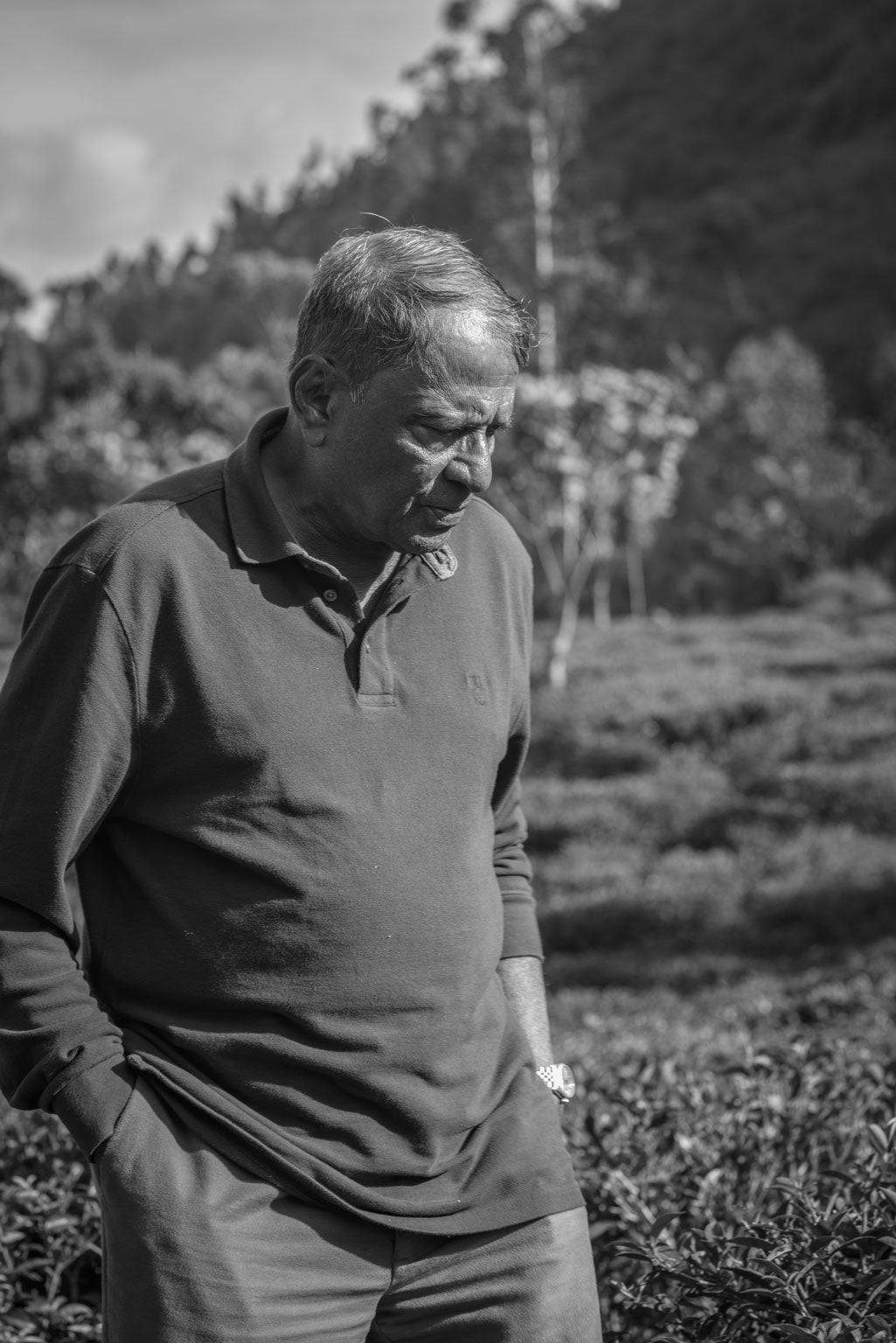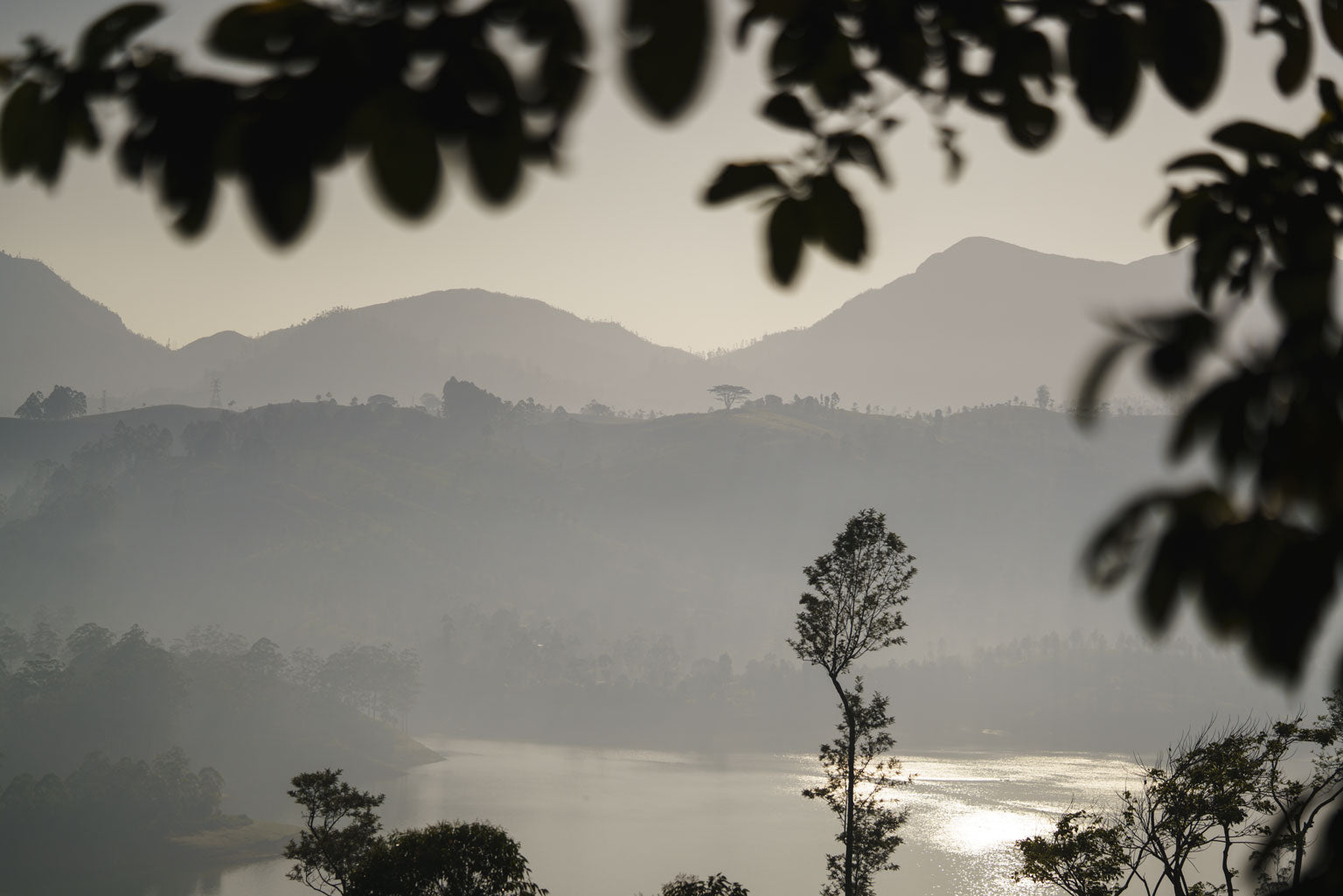HARVEST SEASON
TEA TIME IN PARADISE
DIMBULA DISTRICT, SRI LANKA
Scroll to explore
The Story
IN CONVERSATION WITH HERMAN GUNARATNE
CEYLON TEA MASTER IN DIMBULA DISTRICT, SRI LANKA
Herman Gunaratne is one of a handful of native Sri Lankans who were trained as tea masters by the former British colonial tea companies. Gunaratne has worked in the business for over fifty years, and is one of the most successful and recognized tea makers today. As the deputy chairman of Dilmah Tea, he works alongside the innovative founder of the company, Merrill J. Fernando, to ensure their teas establish the criteria for the highest quality standards. Together, they have protected the coveted status of Ceylon tea by inventing the concept of single origin tea, grown and packaged directly on the estates they manage.
My love
HERMAN GUNARATNE, CEYLON TEA MASTER
of tea translates to
my love of this job.

S+O — WHAT IS CEYLON TEA?
Gunaratne — All tea in this world comes from Camellia sinensis and its subspecies. There are four types of tea found in Sri Lanka, that is black tea, green tea, white tea and oolong tea. We cater to tea palates from all over the world. The Middle East wants one type of tea, the Europeans want another. Sri Lanka is an all-purpose tea provider to all those countries, but our principal product is black tea known as Ceylon.
S+O — HOW DID TEA TRAVEL TO SRI LANKA FROM CHINA?
Gunaratne — The Sri Lankan tea industry is just over one hundred and fifty years old. It was brought here by the British as Sri Lanka was one of the principal colonies of the British empire. At first the British planted coffee, but the coffee encountered a disease that wiped the coffee plantations out. But those planters decided not to give up and looked for an alternative which was tea. Back then the tea trade was going through a difficult time because it was only grown in China and the Sino-Indian border, mostly growing wild. The British had developed a fascination for tea, and the main source of supply was China. The Chinese, realizing this, continued to raise the price of tea to the extent that it was becoming costly for the British to purchase tea. India and Sri Lanka both were already a part of the British empire, so the British decided to introduce tea to the two countries.

S+O — WHAT MADE IT SO SUCCESSFUL HERE?
Gunaratne — Sri Lankan tea is indisputably the best tea in the world. Although the highest priced tea globally, it is a best seller. And that may not be due to any cleverness on our part. God has bountifully blessed this land with a pleasant climate, with a wonderful soil, and with a very pliant workforce. Sri Lankan tea is adored and has the lowest level of insecticides and pesticides.
In my opinion, the most significant contribution to Sri Lanka made by the British was the introduction of Ceylon tea. The Sri Lankan story is a magnificent success story of enduring legacy, because tea is the number one foreign exchange in the country. And more importantly, out of twenty-one million people roughly three and a half million work in the tea industry, the largest employer of people in our country.
S+O — BUT THE WORK FORCE IS LARGELY MADE UP OF TAMIL INDIANS, HOW DID THIS COME ABOUT?
Gunaratne — The British acquired vast tracks of land, but paid a pittance. So a general dysphoria seized the locals who refused to work on the tea plantations. That’s why the British sought workers from the Tamil region of South India. In essence, it is the Indian Tamil plantation worker who has enriched this soil for the last one hundred and fifty years with their sweat and toil.


S+O — HOW DIFFICULT IS THE HARVESTING PROCESS?
Gunaratne — A plucker's hands must move seventeen thousand five hundred times a day for them to get nineteen kilos which are equal to a day’s wage I can tell you that is not an easy task, and it’s what results to the high price of Ceylon tea. The pluckers are serving this country, making a contribution to the entire tea world. And, if you think about it, tea is cheaper than a bottle of Evian water. I don't think countries like Sri Lanka ought to be described as lesser developed. Unlike what many people think, Sri Lanka will reach the highest level of development if it raises the price of tea by a couple of dollars.
A plucker's
hand must move
17,500 times a day for
them to get nineteen
kilos.

S+O — HOW DID YOU BECOME A TEA MASTER?
Gunaratne — The evolution of my career was quite strange. My education qualifications were very minimal, and I did not have many attributes to seek employment in other areas. The only area that would accept a fellow with my minimal qualifications was the tea plantations. When I went into the plantations, I accepted the fact that there was going to be discrimination because all my colleagues were Caucasians. I was the only brown-skinned worker there at the time. I experienced discrimination and realized that the only manner in which it could possibly end would be if I was good at my job. Hence I proceeded to acquire all the necessary skills. I received very rapid promotions and recognition, not only from the British but also from their Sri Lankan counterparts.The passage was not easy but I reached the pinnacle of my career as a tea expert. At one point, when the plantations were nationalized in 1974, I was the manager of over one hundred thousand acres of tea. I worked hard and everybody recognized the contribution I made. There was no magic trick, it was just hard work.
Today, I have my own plantation. And I was invited by Merrill J. Fernando, the owner of Dilmah Tea and Dunkeld Estate, to join the company as deputy chairman.


S+O — HOW LONG HAVE YOU KNOWN MERRILL J. FERNANDO, THE OWNER OF DILMAH TEA AND DUNKELD ESTATE?
Gunaratne — Merrill J Fernando is the founder of Dilmah Tea company. Dilmah is the third largest tea brand in the world. And it is the only brand in the world that consists exclusively of Ceylon tea. I have known him for over twenty-five years. The tea world is small and everybody knows each other.
S+O — WHAT IS HIS SIGNIFICANCE TO THE CEYLON TEA TRADE?
Gunaratne — His story is somewhat similar to mine as a native Sri Lankan. At some point, he must have developed a fondness for tea and he joined the tea trade as a training tea taster. He was sent to England for training. One of his British colleagues had stated, 'You know these Sri Lankans cannot taste tea because their palates are coated with curries and spices.' Merrill proved them wrong. He continued working for various companies over the years, before he realized the way he envisioned the future of tea, could only be done if he did it himself. He started a company which he purposely named Dilmah, which encapsulates the names of his two sons. When we met, there were these reoccurring attempts to import tea which would have permitted teas from other origins to be blended with our local product and still called Sri Lankan tea. We both were in opposition of this, and worked together to defend keeping Sri Lankan tea pristine. He invented the concept of single origin tea as a result. Every estate he operates makes an individual tea, and there’s never any concern about where it is grown or its quality. He has distilled integrity into tea. He believes our tea has the soul of Sri Lanka.
S+O — CAN YOU DESCRIBE THE DUNKELD ESTATE, WHERE WE ARE TODAY, AND THE TEA THAT IT PRODUCES?
Gunaratne — The Dunkeld Estate sits at an elevation of four thousand feet in the Maskeliya district which is a primary tea growing area in the country. It has the most magnificent surroundings. It sits by the side of Castlereagh reservoir and is surrounded by hills which envelop all sides of the plantation. A thick pine forest intercepts the tea plantation. The estate has done an excellent job of preserving nature and respecting the eco system while producing some of the best quality tea on the island. Great tea is made in the field, not in the factory. And the essential prerequisite to make a good tea is to provide the factory with good leaves. A good leaf is two leaves and a bud. We have developed a state-of-the-art tea factory with an emphasis on cleanliness to coincide with the quality leaves from the fields, so that all of the process has the integrity we strive for in every end product.


S+O — WHAT DO YOU LOVE ABOUT THIS WORK?
Gunaratne — My love of tea translates to my love for this job. Besides being the only work I know, it’s a fascinating one, because you can see the results almost overnight. It is the best job in the world because you get to work immersed in nature. I am passionate because, along the way, tea has given me everything. I am one of the happiest people in the world. What you can do with tea is only limited by your own imagination. Whatever the mind can conceive, it can also achieve with tea.

Credits
Photography by Brian Sokol
Film by Oresti Tsonopoulos
Special Acknowledgments - Resplendent Ceylon's Ceylon Tea Trails
The Objects
Exclusive Edition 021 Ceylon Tea B.O.P.
Ceylon black tea has been cultivated in Sri Lanka for just over one hundred and fifty years. First introduced by the British, the island’s fertile soils and dramatic sloping hillsides make for some of the best tea growing areas in the world. The requisite two leaves and a bud are plucked by hand and processed to the highest quality standards resulting in grades that produce the most desirable black tea liquor for drinking with milk, as well as those sought out for the finest tea blends.
The Destination
DIMBULA DISTRICT, SRI LANKA
The Dimbula District is a distinctive part of Sri Lanka’s foremost recognized tea growing region, The Hill Country, which also comprises the picturesque Nuwara Eliya District. Dimbula and its location within the Bogawantalawa, also known as “The Golden Valley” was one of the first areas to be planted in the late nineteen century. Per its nickname, the landscape is most notable for its lush greenery, waterfalls and steeply sloping tea plantations growing what is considered the best quality tea on the island. The difficult to reach region is accessible via a long car journey, a train to nearby Hatton, or more easily a float plane landing directly on Castlereagh Reservoir near the highly recommended Relais & Châteaux Ceylon Tea Trails with views of the Dunkeld Estate tea plantation where our storytelling takes place.



